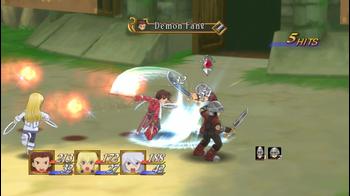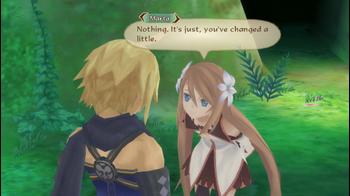
Tales of Symphonia Chronicles Review
When Tales of Symphonia first launched on the Nintendo Gamecube nearly ten years ago, it arrived with a fair amount of fanfare, releasing on a system desperately in need of RPG titles. While not the first game in the long-running JRPG franchise to arrive overseas, Tales of Symphonia is the title that put the Tales of series on the map for many RPG fans. Symphonia is still in many regards the most successful title in the franchise and holds a special place in the memories of the series’ fans today. The game was shortly after ported to PlayStation 2, although this release never saw daylight in the West.
Praised for its action battle system, Tales of Symphonia was a fast and fun RPG that players could sink more than 50 hours into, even with friends, due to local co-operative capability. The battle mechanics would become the backbone of the systems found in future games of the franchise. Several fondly remember the storyline and characters of the game as well. Symphonia was well enough liked, that it spawned a sequel several years later on Nintendo Wii – Tales of Symphonia: Dawn of the New World – featuring an upgraded battle system and new characters. To celebrate the original title’s tenth anniversary, Bandai Namco decided to rerelease both titles as a collection on PlayStation 3 as Tales of Symphonia: Chronicles.
The gameplay in Symphonia remains nearly the same as the original release. Battles are initiated by encountering enemy icons on the screen, which will bring the party to a 3D battle arena for the engagement – typical for the series. While Symphonia features a 3D field unlike some of the early 'Tales of' titles, movement is still restricted to a 2D plane as you can only move your character towards or away from the enemy. Symphonia was an early foray into 3D for the series, and many aspects of the gameplay remain simple and straightforward.
Combos are generally done by chaining a series of attacks using the control stick to vary the actions performed, followed by one or two battle techniques after that. Some passive traits can be set by using ‘Ex Spheres’ which includes abilities such as increased movement speed, and also affect what in battle techniques the character will learn.
Compared to later titles, including Dawn of the New World on the same disc, the skill and battle system in Symphonia can feel too basic at times. While the fluidity was something to behold at the time and is a foundational part of current Tales battle mechanics, it feels a bit dated in the current day, and it lacks some intricacy.
It’s likely you’ll find yourselves repeating similar actions in battles often because there is not much variety in how you can approach the combat. Even so, it is functional and there perhaps there is appeal to some in having its simple structure. You can play as the other play members too of course, so switching members out and trying out different characters is one way to keep things interesting as you learn to master the movesets.
Dawn of the New World features a full 3D battle system similar to Tales of the Abyss or Tales of Vesperia, and while the battle gameplay is improved from its predecessor, there are only two new playable characters, with the rest of the party filled with non-playable monster members. Sometimes the original Symphonia cast will be available to use, but they are often given restrictions in their level cap, which can make putting them in your party more of a nuisance than anything.
The visuals in Tales of Symphonia maintain a ‘chibi’ style, where character models are deformed with unrealistically short proportions. While the game is very colorful and the jump to HD resolutions certainly cleaned it up, some of the textures seemed mostly untouched, leaving blurry surfaces even on main character clothing. In addition, cutscenes in the game are very stilted and rigid compared to a modern presentation. Usually, they involve characters performing their battle animations one at a time during a dramatic scene, and it ends up honestly looking pretty silly, and sometimes even confusing, as character actions don’t flow well in any way. Dawn of the New World has more realistic proportions and utilizes motion capture in some of its cutscenes, so it is better in this regard.
Despite being a bit dated in the visuals and the combat, one place where Tales of Symphonia still shines over much of the rest of the modern Tales series is in the dungeon design. It features numerous locations: temples, enemy bases, mountain paths, forests, etc that are well-paced and of adequate length. Most don’t overstay their welcome and feature an appropriate amount of puzzles, so you never feel like you are just traversing a pathway or lost in a maze. It’s difficult to get bored in these areas because surpassing a dungeon often requires something to figure out: how to open a door, or how get to a certain room. There are many hidden chests that are also not always obvious in how they are obtained.
Later entries in the franchise seem to leave behind this structure and opt for linear dungeons or wide-open fields that act more as battle coliseums than anything else, with nothing to figure out except to follow the path to the end. Replaying Symphonia definitely brought back an appreciation for more intricate dungeon areas. Some do go a little overboard with the idea, such as the Ymir Forest - which requires some tedious path making, or the Temple of Darkness – where it’s frustrating in trying to get NPC creatures to do what you want. Despite some exceptions, this is one of the highlights of the game, unaffected by the game’s age, and something unfortunately missing in much of the rest of the series.
If you’re looking for a JRPG with a fresh, new, and interesting narrative, Symphonia is probably not where you’d want to look for that. Most plot elements are standard-fare, and most of the characters won’t tread new ground. Not to say none of the characters are good or act believably. There’s a good chance there will be a character or two you’ll end up able to relate with regardless. Motivations are largely clear, and the narrative is consistent enough to avoid plot holes, and it generally flows well. But many of the plot elements and characters are quite formulaic. Pacing is also a bit stretched at times. The game is a fairly long one, and sometimes objectives can feel more like padding the game rather than actually progressing the narrative. That said, there is enough intrigue to maintain interest in what happens, even if it’s a fairly commonplace JRPG script.
Tales of Symphonia Chronicles brings both games back into the spotlight in a new coat of paint. New to English players, the enhancements added to the PlayStation 2 port are finally available to be experienced, such as new battle skills and a few sub-events. The games are brought to HD resolutions and set in a widescreen aspect ratio, so image quality will fit on modern HDTVs much more cleanly than a Gamecube quality picture nowadays. For the Chronicles release, there are also a handful of new costumes for the characters which depict outfits from other Tales of titles. However, that’s about where the list of enhancements ends.
The Chronicles release of Tales of Symphonia is based on the PlayStation 2 version of the original game. While the PS2 release of Tales of Symphonia did include some additional skills and events, it suffered some performance issues compared to the Gamecube release. The PS2 port not only featured longer loading times and more slowdowns during world traversal, and it also had to cut the 60FPS battle framerate in half. Chronicles includes a direct HD rerelease of that PS2 port, and unfortunately, the lowered framerate in battle in still present, although loading times and slowdowns have been mitigated somewhat.
This is disappointing for a release that is supposed to be celebrating the title as a sort of ‘definitive edition’ when it doesn’t perform as well as the GameCube version did ten years ago, especially when most of the rest of the console games in the series play at a higher framerate. Considering the action battle nature of the gameplay, the difference is certainly noticeable, especially so if you have recently played Tales of Xillia or other recent Tales of titles. However, I did start to get used to it after sitting down with the game for a while.
Some other small aspects of the Chronicles rerelease seem sloppily or lazily done. While Namco was able to gather the original English actors to provide voices for the new skills and special attacks, many of the new lines don’t match the skill names displayed. Also, characteristic thick black outlines that bordered the character models in the original release are inexplicably lost in the conversion to HD resolutions, leaving the visual style to lose some of its original charm.
Skits – a Tales of series staple where party members engage in conversation during while traveling – also remain voiceless in English. The font used in Chronicles is that used in the original European release. While font preferences might vary from person to person, it would have been nice to include a toggle for those fond of the original North American font. One thing the release did get right however, is the option to switch to Japanese voices, a first for the series. Considering that the skits are voiced in Japanese, and the voice actors are consistent between the two games – unlike the English cast, there is a lot of appeal to those who want to try those voices out.
While there are several things to like about Tales of Symphonia, some might find it hard to go back to a more foundational battle system after some of the more recent action RPG combat systems. The rerelease is about as basic as you can get, with performance issues, localization oddities, and an odd remastering decision or two which leave a lot to be desired. While Symphonia is not a bad JRPG, there was so much more that could have been done to honor the title’s tenth anniversary. That said, Tales of Symphonia is still a fun adventure with undeniably one of the best soundtracks in the franchise. Fans of the franchise might find a purchase worthwhile, even if the game didn’t get the treatment it could have gotten.


